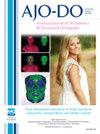评估 3 种矫治器对 II 类 1 种错牙合畸形青少年患者的锚固力和扭矩控制。
IF 2.7
2区 医学
Q1 DENTISTRY, ORAL SURGERY & MEDICINE
American Journal of Orthodontics and Dentofacial Orthopedics
Pub Date : 2025-02-01
DOI:10.1016/j.ajodo.2024.09.005
引用次数: 0
摘要
导言:本研究旨在比较Tweed边缘矫治器、Roth矫治器和PASS矫治器(浙江新亚科技股份有限公司,中国杭州)在固位和扭矩控制方面的差异:本研究收集了90名青少年患者的样本,他们均为角度Ⅱ类1部错牙合畸形(30个Tweed边缘矫治器、30个Roth矫治器和30个PASS矫治器),上颌均有最大锚固要求。首先比较 3 组矫治前的基线水平,然后分别叠加矫治前和矫治后的侧方头影和上颌骨三维(3D)数字模型,分析 3 种矫治器在锚固力和扭矩控制方面的差异:三组患者治疗前的基线水平,包括性别、年龄、矢状骨骼类型(ANB)、垂直骨骼类型(SN-GoGn)、锚固要求和咬合面倾斜度(SN-OP),均无统计学差异。将治疗前和治疗后的侧位头颅照片和三维数字模型分别叠加后,发现侧位头颅照片和三维数字模型的测量结果之间没有统计学差异。在本研究评估的测量变量中,3 个组的上颌第一磨牙的中轴位移、切牙后缩和上颌中切牙的扭矩变化均存在统计学差异。具体而言,与 PASS 组和 Roth 组相比,Tweed 组上颌第一磨牙的中轴位移较低。此外,特威德组上颌中切牙的门牙后缩和扭力变化量最大,其次是罗斯组,然后是 PASS 组。三组的其余测量变量没有统计学差异,包括上颌第一磨牙和中切牙的垂直变化、上颌第一磨牙和犬齿的扭力变化、上颌第一磨牙和犬齿的中轴倾斜变化、上颌第一磨牙之间的宽度变化以及上颌犬齿之间的宽度变化:与现代预调直丝矫治器相比,Tweed边缘矫治器在臼齿固位控制方面更具优势。与罗斯矫治器相比,没有任何辅助锚定装置的PASS矫治器可以充分利用生理性锚定来实现对磨牙锚定的充分控制。临床正畸医生可能需要格外注意生理锚固。托槽设计各自的特点不同,在扭矩控制方面的差异也不同。本文章由计算机程序翻译,如有差异,请以英文原文为准。
Evaluating anchorage and torque control in adolescent patients with Class II Division 1 malocclusion among 3 appliances
Introduction
The objective of this study was to compare the differences in anchorage and torque control among the Tweed edgewise, Roth, and physiological anchorage Spee-wire systems (PASS) appliances (Zhejiang Xinya Technology Co, Ltd, Hangzhou, China).
Methods
A sample of 90 adolescent patients with Angle Class II Division 1 malocclusion (30 Tweed edgewise appliances, 30 Roth appliances, and 30 PASS appliances) with maximum anchorage requirements in the maxilla were collected for this study. The pretreatment baseline levels of the 3 groups were compared initially, and then the differences between the 3 appliances in anchorage and torque control were analyzed after superimposing the pretreatment and posttreatment lateral cephalograms and maxillary 3-dimensional (3D) digital models, respectively.
Results
There was no statistical difference in the pretreatment baseline levels of 3 groups, including gender, age, sagittal skeletal types (ANB), vertical skeletal types (SN-GoGn), anchorage requirements, and occlusal plane inclination (SN-OP). After superimposing the pretreatment and posttreatment lateral cephalograms and 3D digital models, respectively, no statistical differences were observed between the measurement results obtained from lateral cephalograms and 3D digital models. Among the measurement variables assessed in this study, statistical differences were observed in the mesial displacement of maxillary first molars, the incisor retraction, and the torque variation of maxillary central incisors among the 3 groups. Specifically, the Tweed group exhibited lower mesial displacement of maxillary first molars compared with the PASS and Roth groups. Furthermore, the Tweed group exhibited the greatest amount of incisor retraction and torque variation of maxillary central incisors, followed by the Roth group and then the PASS group. The remaining measurement variables for the 3 groups showed no statistical differences, including vertical variation of maxillary first molars and central incisors, torque variation of maxillary first molars and canines, mesiodistal inclination variation of maxillary first molars and canines, width variation between maxillary first molars, and width variation between maxillary canines.
Conclusions
Compared with contemporary preadjusted straight wire appliances, the Tweed edgewise appliance has superiority in molar anchorage control. In contrast, compared with the Roth appliances, the PASS appliances without any auxiliary anchorage devices could make full use of physiological anchorage to achieve adequate control of molar anchorage. Clinical orthodontists may need to pay extra attention to physiological anchorage. The difference in torque control varies depending on the respective characteristics of bracket designs.
求助全文
通过发布文献求助,成功后即可免费获取论文全文。
去求助
来源期刊
CiteScore
4.80
自引率
13.30%
发文量
432
审稿时长
66 days
期刊介绍:
Published for more than 100 years, the American Journal of Orthodontics and Dentofacial Orthopedics remains the leading orthodontic resource. It is the official publication of the American Association of Orthodontists, its constituent societies, the American Board of Orthodontics, and the College of Diplomates of the American Board of Orthodontics. Each month its readers have access to original peer-reviewed articles that examine all phases of orthodontic treatment. Illustrated throughout, the publication includes tables, color photographs, and statistical data. Coverage includes successful diagnostic procedures, imaging techniques, bracket and archwire materials, extraction and impaction concerns, orthognathic surgery, TMJ disorders, removable appliances, and adult therapy.

 求助内容:
求助内容: 应助结果提醒方式:
应助结果提醒方式:


